
The fifth USS Boston was a protected cruiser and one of the first steel warships of the "New Navy" of the 1880s. In some references she is combined with Atlanta as the Atlanta class, in others as the Boston class.

The first USS Chicago was a protected cruiser of the United States Navy, the largest of the original three authorized by Congress for the "New Navy" and one of the U.S. Navy's first four steel ships.
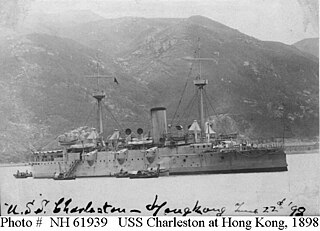
The second USS Charleston (C-2) was a United States Navy protected cruiser — the fourth US protected cruiser to be built. Lacking experience in building steel cruisers, the design was purchased from the British company Armstrong, Mitchell and Co. of Newcastle, the construction to be by an American shipyard. In design, she succeeded the "ABC" cruisers Atlanta, Boston, and Chicago with better protection, higher speed, and similar armament.

The Benham class of ten destroyers was built for the United States Navy (USN). They were part of a series of USN destroyers limited to 1,500 tons standard displacement by the London Naval Treaty and built in the 1930s. The class was laid down in 1936-1937 and all were commissioned in 1939. Much of their design was based on the immediately preceding Gridley and Bagley-class destroyers. Like these classes, the Benhams were notable for including sixteen 21-inch (533 mm) torpedo tubes, the heaviest torpedo armament ever on US destroyers. They introduced a new high-pressure boiler that saved space and weight, as only three of the new boilers were required compared to four of the older designs. The class served extensively in World War II in the Atlantic, Mediterranean, and Pacific theaters, including Neutrality Patrols in the Atlantic 1940-1941. Sterett received the United States Presidential Unit Citation for the Battle of Guadalcanal and the Battle of Vella Gulf, and the Philippine Republic Presidential Unit Citation for her World War II service. Two of the class were lost during World War II, three were scrapped in 1947, while the remaining five ships were scuttled after being contaminated from the Operation Crossroads atomic bomb tests at Bikini Atoll in the Pacific.

USS Atlanta was a protected cruiser and one of the first steel warships of the "New Navy" of the 1880s. In some references she is combined with Boston as the Atlanta class, in others as the Boston class.
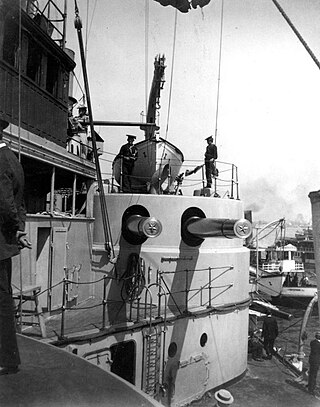
The 8"/35 caliber gun Mark 3 and Mark 4 were used for the main batteries of the United States Navy's first armored cruisers and the secondary batteries for their first battleships, the Indiana-class. The 8"/40 caliber gun Mark 5 initially armed the Pennsylvania-class armored cruisers.
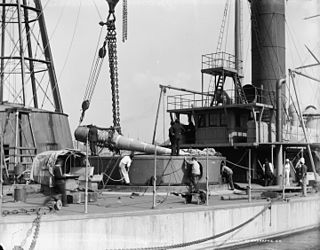
The 10"/31 caliber gun Mark 1 Mod 1 and the 10"/35 caliber gun Mark 1 Mod 2 were both used for the primary batteries of the United States Navy's Amphitrite-class monitor Miantonomoh. The 10"/30 caliber gun Mark 2 was used as main armament on the remaining Amphitrite-class monitors, the monitor Monterey, and the armored cruiser Maine.

The 12"/35 caliber gun were used for the primary batteries of the United States Navy's "New Navy" monitors Puritan and Monterey and the battleships Texas and Iowa.

The 8"/45 caliber Mark 6 gun were used for the secondary batteries of the United States Navy's last pre-dreadnought battleships and refitted in older armored cruisers main batteries.

The 10"/40 caliber gun Mark 3 was used for the main batteries of the United States Navy's last generation of armored cruisers, the Tennessee-class. The Mark 3s were the last, and most powerful, 10-inch (254 mm) guns built for the US Navy.

The 7"/44 caliber gun Mark 1 and 7"/45 caliber gun Mark 2 were used for the secondary batteries of the United States Navy's last generation of pre-dreadnought battleships, the Connecticut-class and Mississippi-class. The 7-inch (178 mm) caliber was considered, at the time, to be the largest caliber weapon suitable as a rapid-fire secondary gun because its shells were the heaviest that one man could handle alone.

The 6"/30 caliber gun Mark 1 were used for the primary battery of the United States Navy's dispatch vessel Dolphin with the Mark 2 being used in the secondary batteries for its "New Navy" protected cruisers Atlanta, Chicago, and Boston and the Mark 3 used for the primary and secondary batteries in the succeeding early protected cruisers in addition to secondary batteries in the "Second Class Battleships" Maine and Texas.

The 6"/40 caliber gun Mark 4 were used for the secondary batteries of the United States Navy's Indiana-class and Illinois-class battleships. They were also used as the main battery on the Cincinnati-class protected cruisers.
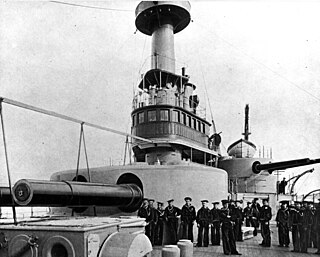
The 13"/35 caliber gun Mark 1 was used for the primary batteries on eight of the first nine battleships in the United States Navy, Indiana-class, Kearsarge-class and Illinois-class; USS Iowa (BB-4) used the 12-inch (305 mm)/35 caliber gun.

The 4"/40 caliber gun was used for the secondary batteries on the United States Navy's battleship Iowa, Columbia-class protected cruisers, and the armored cruiser New York, and was the primary batteries on the gunboats Nashville, Wilmington, and Helena.
The 5"/31 caliber gun were used in the secondary batteries of the United States Navy's "New Navy" protected cruiser Chicago and later mounted in Panther during the Spanish–American War.
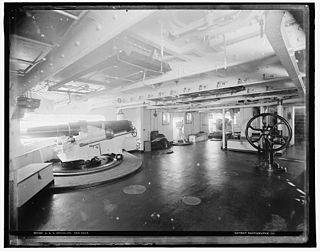
The 5″/40 caliber gun were used in the secondary batteries of the United States Navy's early battleships, armored cruisers, protected cruisers, unprotected cruisers, and auxiliary cruisers.

The 5"/50 caliber gun was the first long barrel 5-inch (127 mm) gun of the United States Navy and was used in the secondary batteries of the early Delaware-class dreadnought battleships, various protected cruisers, and scout cruisers. They were also refitted in the secondary batteries of the armored cruiser New York and the New Orleans-class protected cruisers. They were later used on cargo ships, store ships and unclassified auxiliaries during World War II as well as in emergency coastal defense batteries.
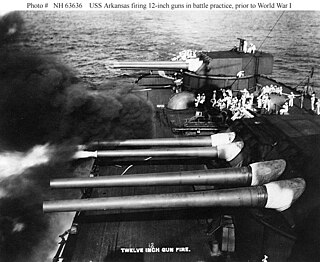
The 12"/50 caliber Mark 7 gun was a United States Navy's naval gun that first entered service in 1912. Initially designed for use with the Wyoming class of dreadnought battleships, the Mark 7 also armed the Argentine Navy's Rivadavia-class battleships.

The 6"/50 caliber gun Mark 6 and Mark 8 were used for the secondary batteries of the United States Navy's Maine-class and Virginia-class battleships, as well as the Pennsylvania-class and Tennessee-class armored cruisers. They were also used as the main battery on the St. Louis-class protected cruisers.





















